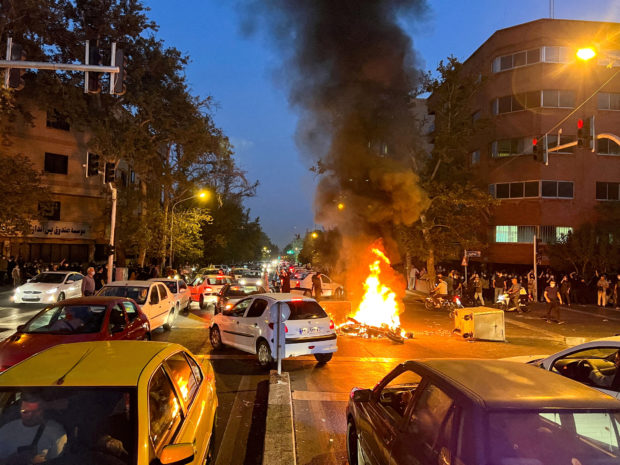
FILE PHOTO: A police motorcycle burns during a protest over the death of Mahsa Amini, a woman who died after being arrested by the Islamic republic’s “morality police,” in Tehran, Iran September 19, 2022. WANA (West Asia News Agency) via REUTERS
PARIS — Iran carried out its first known execution Thursday over protests sparked by Mahsa Amini’s death, hanging a man convicted of blocking a street and wounding a paramilitary member in what human rights activists condemned as “show trials”.
Demonstrations have swept Iran for nearly three months since Amini died after her arrest by the morality police in Tehran for an alleged breach of the country’s strict hijab dress code for women.
“Mohsen Shekari, a rioter who blocked Sattar Khan Street in Tehran on September 25 and wounded one of the security guards with a machete, was executed this morning,” the judiciary’s Mizan Online website said.
The ruling was condemned by human rights activists based abroad.
The “execution of Mohsen Shekari must be met with strong reactions otherwise we will be facing daily executions of protesters,” said Mahmood Amiry-Moghaddam, director of Oslo-based group Iran Human Rights (IHR).
He said Shekari had been “sentenced to death in show trials without any due process”.
“This execution must have rapid practical consequences internationally,” he tweeted.
The revolutionary court in Tehran heard Shekari had been arrested after striking the member of the Basij paramilitary force in the shoulder with the blade, an injury that required 13 stitches, Mizan Online said.
The judiciary said Shekari was found guilty of fighting and drawing a weapon “with the intention of killing, causing terror and disturbing the order and security of society”.
It convicted him of “moharebeh” — or waging “war against God” under Iran’s Islamic sharia law — on November 1, said Mizan, adding that he appealed the ruling but the supreme court upheld it on November 20.
Hundreds killed in crackdown
Since the September 16 death in custody of Amini, a 22-year-old Iranian of Kurdish origin, women, university students and schoolgirls have led the demonstrations.
Their largely peaceful protest actions have included removing and burning their headscarves in the streets, chanting anti-government slogans and confronting the security forces.
Iran, which has struggled to contain the protests, describes them as “riots” fomented by its arch foe the United States and its allies, including Britain and Israel.
Its security forces have responded with a crackdown that has killed at least 458 people, including 63 children, according to an updated death toll issued by IHR on Wednesday.
The crackdown, which has drawn widespread international criticism, has seen thousands of people arrested, including academics, journalists and lawyers.
The United Nations Human Rights Council on November 24 voted to create a high-level investigation into the crackdown.
The Basij is a state-sanctioned volunteer force that is linked to Iran’s powerful Islamic Revolutionary Guard Corps.
An Iranian court on Tuesday sentenced five people to death by hanging for killing a Basij member, a ruling condemned by human rights activists as a means to “spread fear” and to stop the protests.
The judgement brought to 11 the number of people in Iran sentenced to death in connection with the protests, in what Amnesty International has branded “sham trials”.
Prior to the latest execution, the London-based rights group said at least 28 people, including three children, could face the death penalty in connection with the nationwide protests.
It accused the Iranian authorities of using “the death penalty as a tool of political repression to instill fear among the public and end the popular uprising”, in a statement issued on December 2.
RELATED STORIES
Protest-hit Iran abolishes morality police
Activists claim Instagram blocking Iran protest content

